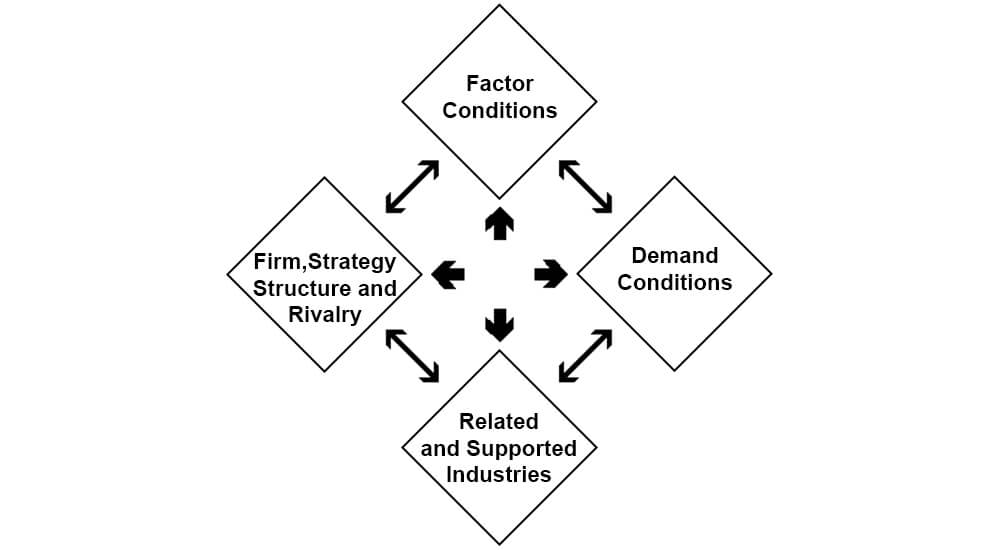The Porter’s Diamond Model helps countries and businesses to analyze the competitive environment. It attempts to explain why certain groups, countries, or regions are more successful.
Michael E. Porter, a Harvard Business School professor, developed Porter’s Diamond Model.
In this blog post, we will discuss Porter’s Diamond Model in detail and provide examples of how it can be used to improve business competitiveness.
The 4 Factors of Porter’s Diamond Model Strategy
Porter’s Diamond Model is a framework that helps businesses understand the factors that influence their ability to compete in global markets. The model can assess a country’s strengths, weaknesses and develop strategies to succeed.

According to the Project Management Institute (PMI, USA), strategic frameworks are essential to business success. The Porter’s Diamond Model pinpoints four crucial factors that influence global competitiveness:
Porter’s Diamond Model considers four factors:
- Factor Conditions
- Demand Conditions
- Related and Supporting Industries
- Firm Strategy, Structure, and Rivalry.
Factor Conditions
Factor conditions are the basic factors of production that a country has access to. This includes land, labor, capital, and infrastructure. Factor conditions can be a competitive advantage if they are superior to other countries.
For instance, the U.S. boasts advanced infrastructure, which, according to the U.S. Department of Transportation, aids in efficiently transporting goods.
These factors can be grouped into three categories: Natural resources, human resources, and infrastructure.
Natural resources include oil, gas, minerals, forests, and fisheries. A country with natural resources can use them for economic gain. For example, Saudi Arabia is wealthy because of its oil resources.
Human resources are the workforce. A country with an educated and skilled workforce will produce high-quality goods and services. Countries like Germany and Japan have highly skilled workers and are known for their high-quality products.
Infrastructure includes roads, railways, ports, telecommunications, etc. A country with a well-developed infrastructure can transport goods and services more efficiently. China is the world’s second-largest economy because of its high-quality and accessible infrastructure.
Demand Conditions
Demand conditions refer to the domestic demand for a good or service. A country with a large and growing market is a better destination than countries with a small or stagnant market.
Apart from the domestic market’s size, the demand level also matters. A country with high demand for its products will be more successful than one with low demand levels.
Income levels, tastes, and preferences can influence demand conditions. If a product or service has a high demand, it is a competitive advantage.
Related and Supporting Industries
Related and supporting industries are the businesses that supply inputs or purchase businesses’ outputs.
For example, an organization that manufactures cars would have steel, plastic, and other materials suppliers. It would also have customers who buy its cars. These related and supporting industries can be a source of competitive advantage.
Businesses need suppliers and customers to be successful.
A country with related and supporting industries is more successful than one with fewer related and supporting industries.
Firm Strategy, Structure, and Rivalry
Firm strategy, structure, and rivalry refer to how a company is organized and competes. Well-organized countries with a competitive environment are more successful than poorly organized countries with no competition.
This is because well-organized firms can develop and implement strategies effectively and respond quickly to market changes. Additionally, aggressive competition drives down prices and encourages innovation.
This factor can be influenced by the level of competition, the firm’s financial position, government regulations, etc. If these conditions are favorable, they can be a competitive advantage. The government can play a role in promoting competitiveness by enacting policies that encourage firms to compete.
Why Is Porter’s Diamond Model Important?
Porter’s Diamond Model is important because it helps businesses and countries understand the sources of competitive advantage. It helps them identify the most critical factors to their success.
By understanding the factors that contribute to competitive advantage, countries can make policies that will enable them to compete more effectively in the global marketplace. This also allows policymakers to see the areas for improvement.
Additionally, the model can help companies understand the factors influencing their competitiveness and make the necessary changes to stay ahead of the competition. These factors can be internal, external, static, or dynamic.
Porter’s Diamond Model is also important because it can be used to benchmark a company’s performance. Benchmarking allows companies to see where they stand relative to their competitors and take steps to improve.
Porter’s Diamond Model is a valuable tool for businesses and policymakers. It provides a framework for understanding competitiveness and can be used to make improvements.
A Case Study – Germany’s Luxury Car Manufacturing Industry
The German luxury car manufacturing industry is a good example of Porter’s Diamond Model.
The following are some factors contributing to the success of this industry:
- Germany has a large and well-developed automotive industry. This provides a pool of skilled workers and suppliers and gives firms access to capital and technology.
- The industry is highly competitive. This drives down prices and encourages innovation. The competition ensures that only the best product survives.
- The government has enacted policies that are favorable to the automotive industry. These policies have helped to make Germany a leading producer of luxury cars. The government provides subsidies and tax breaks to firms in the industry.
- Firms in the industry are well-organized and compete aggressively. This allows them to develop and implement strategies effectively.
- The industry is supported by many related and supporting industries. This provides firms with resources and strengthens the industry’s competitive position.
The German luxury car manufacturing industry is an excellent example of how Porter’s Diamond Model can be used to understand and explain competitiveness. By understanding the factors that contribute to their success, firms in this industry can improve their performance.
Porter’s Diamond Model Examples
Example 1
Let’s look at Porter’s Diamond Model in the steel industry.
The factors that contribute to competitive advantage in the steel industry are:
- Access to raw materials
- Location
- Skilled workforce
- Good infrastructure
- Strong competition
Each of these factors can be a source of competitive advantage for steel companies. For example, if a steel company has access to raw materials, it can produce more steel at less expense than its competitors. If it is in a good location, it can ship its products more cheaply. If it has a skilled workforce, it can produce steel more efficiently.
Porter’s Diamond Model can help policymakers and businesses to understand these factors and how they contribute to competitive advantage. The information obtained from this model can be used to make necessary policy changes.
Example 2
Let’s look at Porter’s Diamond Model in the airline industry. The model shows why some airlines are more successful.
The four factors contributing to competitive advantage in this industry are firm strategy, structure, and rivalry; related and supporting industries; factor conditions; and demand conditions.
Firm strategy, structure, and rivalry refer to how an airline is organized and competes in the market. A well-organized airline will be more successful than a poorly organized one. Additionally, aggressive competition drives down prices and encourages innovation.
Related and supporting industries are essential because they provide an airline’s inputs to operate. These industries include aircraft manufacturers, airport operators, and fuel suppliers. A country with a strong aerospace industry will be more successful than one without a strong aerospace industry.
Factor conditions are the resources and capabilities that an airline has. Human resources, technology, and capital are all critical factor conditions. Airlines with resources are more successful than those lacking these resources.
Demand conditions are the needs and wants of consumers. Airlines will be more successful if there is a strong demand for air travel.
By understanding these factors, airlines can identify the sources of their competitive advantage and take steps to improve them.
Criticisms of Porter’s Diamond Model
Porter’s Diamond Model has been criticized for several reasons.
- First, the model does not consider the role of government policy. Government policy can be a significant factor in determining competitiveness. For example, countries with protectionist policies are difficult places for businesses to compete.
- Second, the model does not take into account the role of culture. Culture can play a significant role in determining competitiveness. For example, countries with collectivist cultures make it difficult for organizations to compete.
- Third, the model does not take into account the role of entrepreneurship. Entrepreneurship can play a significant role in determining competitiveness. For example, a company with a creative and innovative CEO will be more successful.
- Finally, the model is static and does not consider changes in the environment. Environmental factors, such as technology and globalization, can significantly impact competitiveness.
Key Takeaways
- The four factors contributing to competitive advantage in an industry are firm strategy, structure, and rivalry; related and supporting industries; factor conditions; and demand conditions.
- Germany’s luxury car manufacturing industry is a good example of Porter’s Diamond Model in action.
- The model has been criticized for many reasons, including the fact that it does not consider the role of government policy, culture, entrepreneurship, or changes in the environment.
- Understanding the factors contributing to competitive advantage and its limitations can help one utilize Porter’s Diamond Model effectively.
Conclusion
Porter’s Diamond Model is an important tool for business owners to improve their operations and create a competitive edge. By understanding the unique factors that affect their industry and country, businesses can develop targeted strategies to give them a leg up on the competition.
Porter’s Diamond Model is not a stand-alone tool and is used with other frameworks. It is essential to use the model to understand a specific industry and country.

Good explanation ❤️❤️